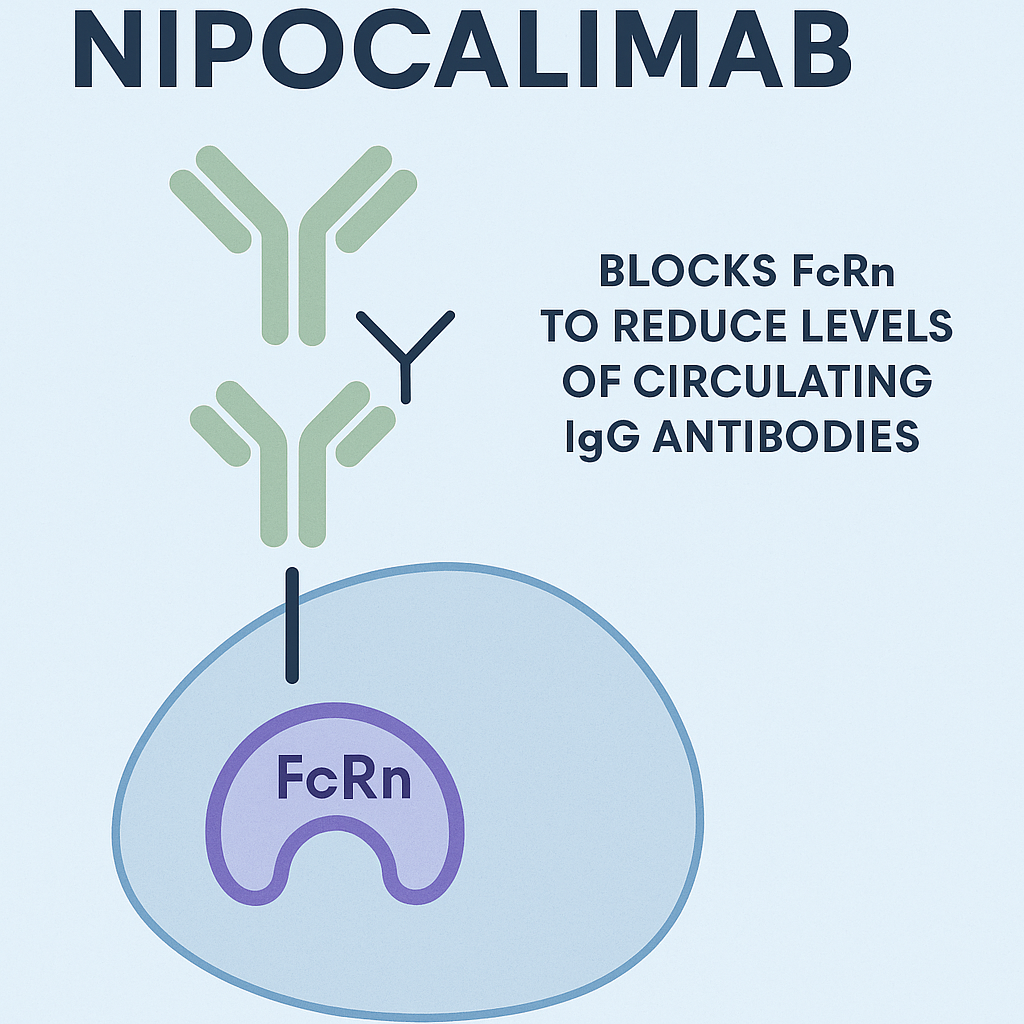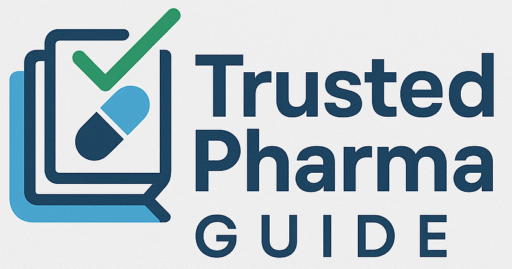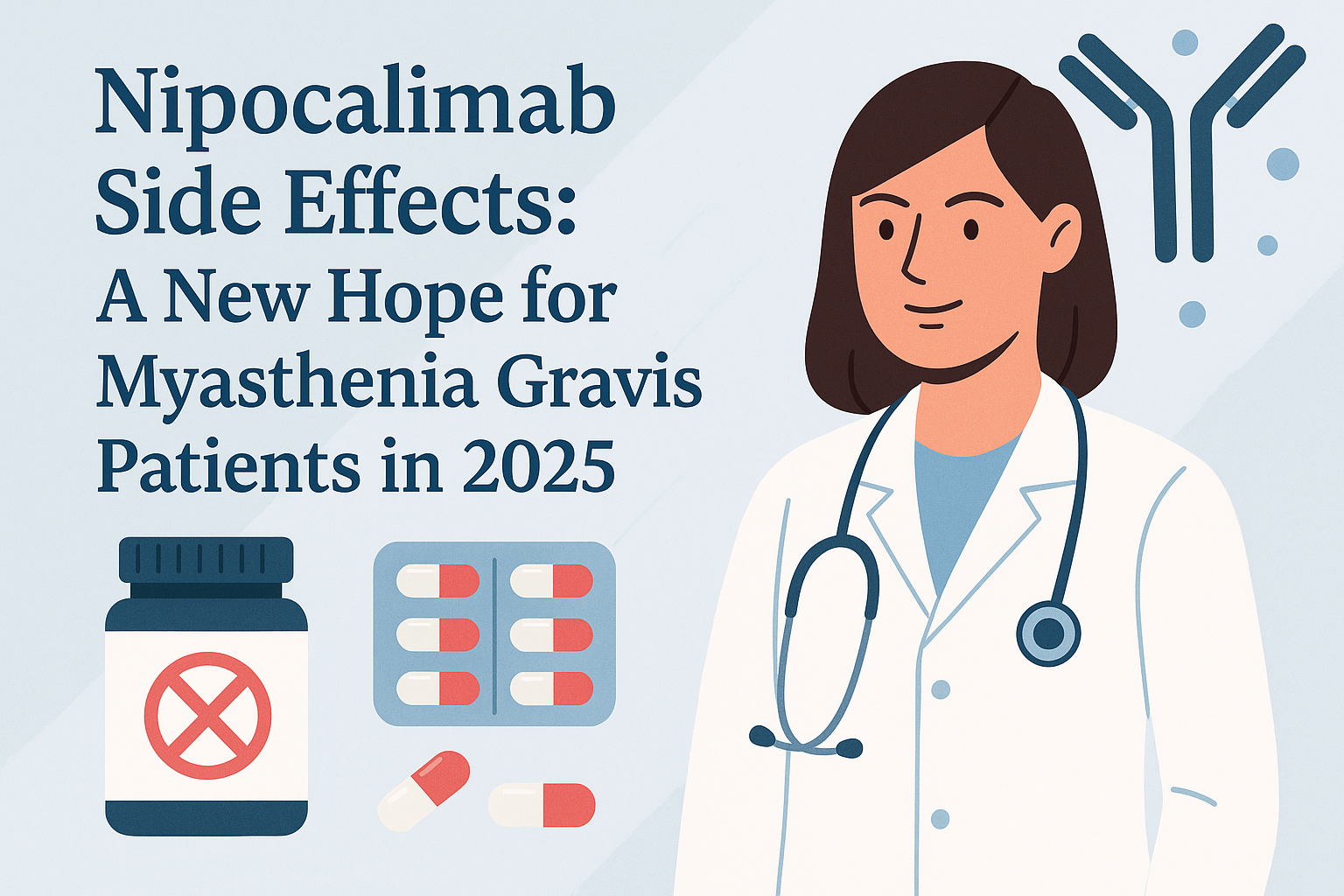Generic Name : Nipocalimab
Brand Name : Imaavy
Drug Class : Anti-neonatal Fc receptor (FcRn) monoclonal antibody
Dosage form : Injection .
Table of Contents
Introduction :
Autoimmune diseases have long presented challenges in treatment and management. One such condition is myasthenia gravis (MG), a chronic autoimmune neuromuscular disorder that causes weakness in skeletal muscles. In 2024, a breakthrough treatment called nipocalimab attracted attention for its novel mechanism and therapeutic promise. Its efficacy is promising, but understanding the nipocalimab side effects is important for both patients and healthcare professionals.
What is Nipocalimab?
Nipocalimb is a completely human, aglycosylated IGG1 monoclonal antibodies. It works by binding the newborn infant (FcRn ) neonatal Fc receptor, which reduces half the life of the pathogenic IGG autointibodies. These autoithbidies are the major drivers in autoimmune diseases such as mythological gravis.
Developed by Johnson & Johnson’s Janson Pharmaceuticals, Nipocalimb’s MG, hemolytic disease (HDFN) and warm autoimmune hemolitic anemia (wAIHA) have been evaluated in many clinical tests for autoimmune diseases.
How Nipocalimab Works (Mechanism of Action) :
Nipocalimab targets the nascent Fc receptor (FcRn), which plays a critical role in the recycling and long-term persistence of IgG antibodies in the body.
By binding to FcRn:
• It blocks the IgG recycling pathway.
• Pathogenic IgG is rapidly degraded.
• Autoimmune activity is significantly reduced.
• It improves muscle strength in MG patients.
This unique immunomodulatory action sets nipocalimab apart from conventional immunosuppressive therapy.

Indication: Nipocalimab for Myasthenia Gravis
Myasthenia gravis (MG) is characterized by muscle weakness, often worsening with activity and improving with rest. Symptoms include:
• Tosis (drooping eyelids)
• Dysphagia (difficulty swallowing)
• Diplopia (double vision)
• Generalized muscle fatigue
Nipocalimab is being studied for generalized myasthenia gravis (GMG). It targets IgG autoantibodies against acetylcholine receptors (AChRs) or muscle-specific kinase (MSK), reducing their levels and thereby reducing symptoms.
Dosage and Administration :
According to the latest clinical trial data:
• Nipocalimpab is administered by intravenous (IV) infusion.
• A typical dose is based on weight (mg/kg) and is administered weekly or bi-weekly.
• Ongoing studies are investigating a subcutaneous form for easier administration.
Always follow the dosing instructions provided by your healthcare provider.
Nipocalimab Side Effects :
Like all biologics, nipocalimab side effects vary from mild to severe. Based on Phase 2 and 3 clinical trials, common and serious side effects are listed below:
✅ Common Nipocalimab Side Effects:
| Side Effect | Frequency |
|---|---|
| Headache | Very Common |
| Fatigue | Common |
| Nausea | Common |
| Injection site reaction | Common |
| Upper respiratory tract infection | Common |
⚠️ Serious Nipocalimab Side Effects:
| Side Effect | Description |
|---|---|
| Severe infections | Due to immune suppression |
| Hypersensitivity or allergic reaction | Rash, itching, or anaphylaxis |
| Anemia or thrombocytopenia | Low blood counts |
| Elevated liver enzymes | Requires monitoring |
Note: Long-term immunosuppression may increase the risk of opportunistic infections. Regular monitoring is essential.
Clinical Trials and Efficacy :
In a 2024 multicenter, randomized, placebo-controlled Phase 3 trial (NCT04115293):
- Nipocalimab significantly reduced IgG autoantibody titers.
- 68% of patients showed a ≥4-point improvement in the Myasthenia Gravis Activities of Daily Living (MG-ADL) score.
- Improvement was seen within 2-4 weeks of treatment.
- Sustained effects were observed for up to 12 weeks post-treatment.
These results position nipocalimab as a first-in-class FcRn inhibitor for MG.
Comparisons with Other Therapies :
| Drug | Mechanism | Route | Side Effects |
|---|---|---|---|
| Pyridostigmine | AChE inhibitor | Oral | GI upset, cramps |
| Prednisone | Corticosteroid | Oral | Weight gain, mood swings |
| Eculizumab | Complement inhibitor | IV infusion | Meningococcal infection |
| Nipocalimab | FcRn blocker | IV infusion | Headache, fatigue, infection |
Nipocalimab offers targeted action with fewer systemic side effects compared to corticosteroids or broader immunosuppressants.
Advantages of Nipocalimab :
- Targeted immunosuppression
- Non-steroidal alternative
- Suitable for patients with AChR+ and MuSK+ MG
Storage & Handling :
- Store nipocalimab vials at 2°C to 8°C (36°F to 46°F).
- Do not freeze or shake.
- Once diluted for infusion, it should be used immediately or within 4 hours at room temperature.
Precautions and Warnings :
- Screen for latent infections (e.g., TB, hepatitis).
- Use with caution in pregnant or breastfeeding women.
- Avoid concurrent use with other strong immunosuppressants unless prescribed.
Conclusion :
Nipocalimab represents a powerful and promising therapy for patients suffering from myasthenia gravis. Its targeted mechanism, rapid action, and relatively mild side effect profile make it a potential game changer. However, understanding the nipocalimab side effects is essential for its safe and effective use.
As clinical trials advance, nipocalimab could soon become a standard-of-care treatment for autoimmune neuromuscular disorders.
FAQs About Nipocalimab
Q1: Is nipocalimab FDA-approved?
Q2: Can nipocalimab cause cancer?
Q3: Can it be used with other MG drugs?
Q4: How soon do patients feel relief?
Q5: What’s the cost of nipocalimab?
Q6 :What are the nipocalimab side effects ?
Disclaimer: This blog post is for informational purposes only and does not constitute medical advice. Always consult a qualified healthcare professional before making any medical decisions.

